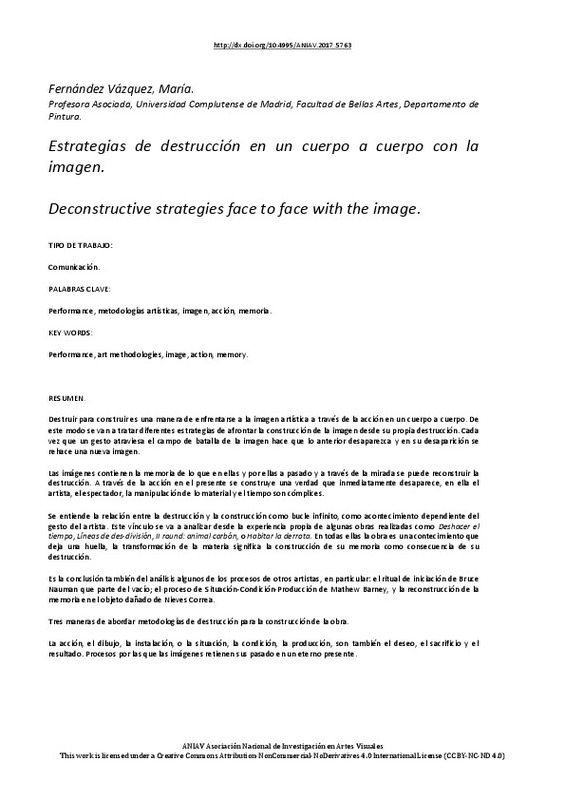JavaScript is disabled for your browser. Some features of this site may not work without it.
Buscar en RiuNet
Listar
Mi cuenta
Estadísticas
Ayuda RiuNet
Admin. UPV
Estrategias de destrucción en un cuerpo a cuerpo con la imagen
Mostrar el registro sencillo del ítem
Ficheros en el ítem
| dc.contributor.author | Fernández Vázquez, María
|
es_ES |
| dc.date.accessioned | 2018-09-07T06:50:48Z | |
| dc.date.available | 2018-09-07T06:50:48Z | |
| dc.date.issued | 2017-10-23 | |
| dc.identifier.isbn | 9788490485736 | |
| dc.identifier.uri | http://hdl.handle.net/10251/106743 | |
| dc.description.abstract | [EN] To destroy in order to build is a way to face the artistic image through the hand`to`hand action. Thus, I will deal with different strategies to confront the construction of the image from its own destruction. Every time a gesture crosses the image’s battlefield, everything previous to that moment disappears and in its own disappearance, a new image is rebuilt. Images contain the memories of what has passed in and through them and, through the way we look at them, one can rebuild the destruction. A truth that immediately disappears is built through the action in the present. In that truth the artist, the spectator, the manipulation of the material and time become accomplices. One can understand the relationship between destruction and construction as an infinite loop, as an event dependent upon the artist’s gesture. This bond will be analyzed through my own experience in some works performed such as Undoing Time (Deshacer(el(tiempo), De`divisional Lines (Líneas(de(desGdivisión), Il round col animal (II(round (animal(carbón), or To Inhabit the defeat (Habitar(la(derrota). In all of them, the performance is the event that leaves a trace, the transformation of the matter signifies the construction of its memory as a consequence of its destruction. It is also the conclusion of some of other artists’ processes, specifically found in Bruce Nauman’s rite of passage which draws from emptiness as a concept, Matthew Barney’s process of Situation`Condition`Production, and Nieves Correa’s reconstruction of memory in the damaged object. Three different ways to deal with methodologies of destruction in the process of the work’s construction. The action, drawing, installation, or the situation, condition, production, is also the desire, sacrifice and the result. All of them processes through which the images contain their pasts in an eternal present. | es_ES |
| dc.description.abstract | [ES] Destruir para construir es una manera de enfrentarse a la imagen artística a través de la acción en un cuerpo a cuerpo. De este modo se van a tratar diferentes estrategias de afrontar la construcción de la imagen desde su propia destrucción. Cada vez que un gesto atraviesa el campo de batalla de la imagen hace que lo anterior desaparezca y en su desaparición se rehace una nueva imagen. Las imágenes contienen la memoria de lo que en ellas y por ellas a pasado y a través de la mirada se puede reconstruir la destrucción. A través de la acción en el presente se construye una verdad que inmediatamente desaparece, en ella el artista, el espectador, la manipulación de lo material y el tiempo son cómplices. Se entiende la relación entre la destrucción y la construcción como bucle infinito, como acontecimiento dependiente del gesto del artista. Este vínculo se va a analizar desde la experiencia propia de algunas obras realizadas como Deshacer el tiempo, Líneas de des-división, II round: animal carbón, o Habitar la derrota. En todas ellas la obra es un acontecimiento que deja una huella, la transformación de la materia significa la construcción de su memoria como consecuencia de su destrucción. Es la conclusión también del análisis algunos de los procesos de otros artistas, en particular: el ritual de iniciación de Bruce Nauman que parte del vacío; el proceso de Situación-Condición-Producción de Mathew Barney, y la reconstrucción de la memoria en el objeto dañado de Nieves Correa. Tres maneras de abordar metodologías de destrucción para la construcción de la obra. La acción, el dibujo, la instalación, o la situación, la condición, la producción, son también el deseo, el sacrificio y el resultado. Procesos por las que las imágenes retienen sus pasado en un eterno presente. | es_ES |
| dc.format.extent | 8 | es_ES |
| dc.language | Español | es_ES |
| dc.publisher | Editorial Universitat Politècnica de València | es_ES |
| dc.relation.ispartof | Glocal [codificar, mediar, transformar, vivir] III Congreso Internacional de Investigación en Artes Visuales | es_ES |
| dc.rights | Reconocimiento - No comercial - Sin obra derivada (by-nc-nd) | es_ES |
| dc.subject | Performance | es_ES |
| dc.subject | Metodologías artísticas | es_ES |
| dc.subject | Imagen | es_ES |
| dc.subject | Acción | es_ES |
| dc.subject | Memoria | es_ES |
| dc.subject | Art methodologies | es_ES |
| dc.subject | Image | es_ES |
| dc.subject | Action | es_ES |
| dc.subject | Memory | es_ES |
| dc.title | Estrategias de destrucción en un cuerpo a cuerpo con la imagen | es_ES |
| dc.title.alternative | Deconstructive strategies face to face with the image | es_ES |
| dc.type | Capítulo de libro | es_ES |
| dc.type | Comunicación en congreso | es_ES |
| dc.identifier.doi | 10.4995/ANIAV.2017.5763 | |
| dc.rights.accessRights | Abierto | es_ES |
| dc.description.bibliographicCitation | Fernández Vázquez, M. (2017). Estrategias de destrucción en un cuerpo a cuerpo con la imagen. En Glocal [codificar, mediar, transformar, vivir] III Congreso Internacional de Investigación en Artes Visuales. Editorial Universitat Politècnica de València. 238-245. https://doi.org/10.4995/ANIAV.2017.5763 | es_ES |
| dc.description.accrualMethod | OCS | es_ES |
| dc.relation.conferencename | III Congreso Internacional de Investigación en Artes Visuales :: ANIAV 2017 :: GLOCAL | es_ES |
| dc.relation.conferencedate | Julio 06-07,2017 | es_ES |
| dc.relation.conferenceplace | Valencia, Spain | es_ES |
| dc.relation.publisherversion | http://ocs.editorial.upv.es/index.php/ANIAV/ANIAV2017/paper/view/5763 | es_ES |
| dc.description.upvformatpinicio | 238 | es_ES |
| dc.description.upvformatpfin | 245 | es_ES |
| dc.type.version | info:eu-repo/semantics/publishedVersion | es_ES |
| dc.relation.pasarela | OCS\5763 | es_ES |








